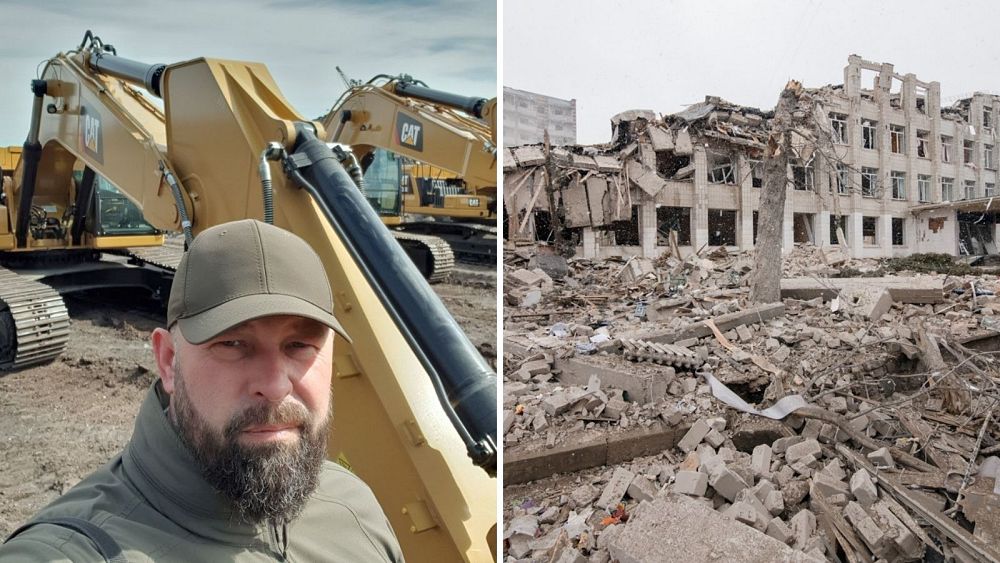
Homes, theatres, hospitals and office buildings have been reduced to rubble across Ukraine. They’re currently little more than a backdrop for the human suffering of the war.
Around 120,000 private houses were destroyed or damaged, and 20,000 apartment blocks hit by Russian air strikes, a Ukrainian minister said last July. Statistics from the start of this year put the total damage to physical infrastructure at over €128 billion.
Alongside the huge economic cost of rebuilding the country, there’s also a slow environmental burn.
Millions of tonnes of construction waste threaten to overwhelm Ukraine’s landfills. Building from scratch would release vast amounts of greenhouse gas emissions.
Concrete is the most widely-used man-made substance on Earth. The cement used as a binding ingredient within it is responsible for around 8 per cent of the world’s CO2 emissions – more than aviation fuel.
A Ukrainian building company is looking for solutions
“What should be done with such a massive quantity of construction waste?” That’s the question that Dmitry Rodionov, director of the construction company Kopach Profi, has been asking himself.
He founded the firm in the eastern city of Dnipro in 2019 and was working round the clock when Russia invaded Ukraine in February last year.
Kopach was processing waste at one of the country’s largest metallurgical plants in nearby Zaporizhzhia. Seven days a week its equipment extracted useful products from the 200,000 tonnes of material dumped every month.

Now the plant has stopped, Rodionov tells Euronews Green. “We have had to seek other directions for our activities to maintain our staff and be as useful as possible to our country’s economy in this difficult time.”
“The majority of populated areas in our country have been completely or partially destroyed,” he claims.
“We have decided to focus on recycling the construction waste generated from the demolished buildings and structures.”
Can concrete waste be recycled?
The problem, explains Rodionov, is that most technologies only grind the broken concrete into a low-grade gravel which contains numerous impurities. It is fine as a base for roads, but unsuitable as a primary construction material for buildings.
That’s why Kopach is looking to the example of other European countries which have been pioneering new recycling methods.
In its guidelines, the EU is moving closer to a ‘closed loop of demolition’, where a much smaller proportion of building waste is sent to landfills. New jobs are also created in the process.
Some European countries are doing better than others on this front. In the Netherlands waste can only be buried where no recovery is possible. As for recycled concrete, Switzerland is leading the way with 18 per cent of concrete the country uses containing recycled materials.
But there was one new method in particular that caught Rodionov’s eye.
A new method for recycling concrete

A professor at Vrije Universiteit Brussel (VUB) has teamed up with innovators in Belgium and the Netherlands to develop a more complete way of recycling concrete.
The building staple is made up of stones or gravel, sand, a binder – typically cement – and water. All these solid components can be extracted from waste, explains Professor Hubert Rahier.
“Sand and gravel come loose from the concrete if you grind it mechanically in a particular way. The finer part containing the hydrated and thus ‘finished’ cement must then be reprocessed until it becomes usable again as a binder.”
Dutch company Slim Breker has created the eponymous ‘SmartCrusher’ machine which does the separating.
A specially designed high-powered microwave oven then gets to work on the cement power, heating it up to 600°C to break it out of its chemical bond and return it to a reusable state.
“This uses electricity generated by solar panels, at our partner Rutte in Zaandam, so the whole process can be done without additional carbon emissions,” Rahier says.
Rodionov wrote to the professor after reading about the process online and was “pleasantly surprised” to hear back. Conversations with Rahier and Slim Breker’s managing director Koos Schenk have been aided by a Ukrainian translator living in Brussels.
“This once again confirms that wherever we are, every Ukrainian is ready to contribute to the development and restoration of our country,” says Rodionov.
What are the challenges for recycled demolished buildings in Ukraine?

The new technology isn’t quite ready to be rolled out yet, however. Some fine-tuning is needed for the SmartCrusher but Rahier says he expects the equipment will be ready by the end of the year.
Rebuilding in a warzone has its own hazardous timeline. “This is not an easy path,” acknowledges Rodionov. “First, it is necessary to conduct a survey of the objects by specialised services for the presence of explosive objects, which is quite laborious and time-consuming.”
After removing potential dangers, workers will dismantle the debris and remnants of structures, sorting and processing the different kinds of waste before recycling can begin.
Rodionov is keen to start in areas that have suffered significant damage but are located away from the frontline. This includes Bucha, Hostomel and Kyiv in the Kyiv region, as well as parts of Kharkiv and Zaporizhzhia – where Kopach is now based.
“But we believe that when the war is over, we will have the opportunity to restore the entire territory of Ukraine, given the colossal destruction in cities such as Bakhmut, Mariinka, Kramatorsk, and Mariupol in the Donetsk region.”
State support will be needed at the legislative level, he adds. And the construction boss has appealed to other European companies with experience or equipment for processing destroyed buildings and structures.
“Our doors are always open to new technologies,” he says.


